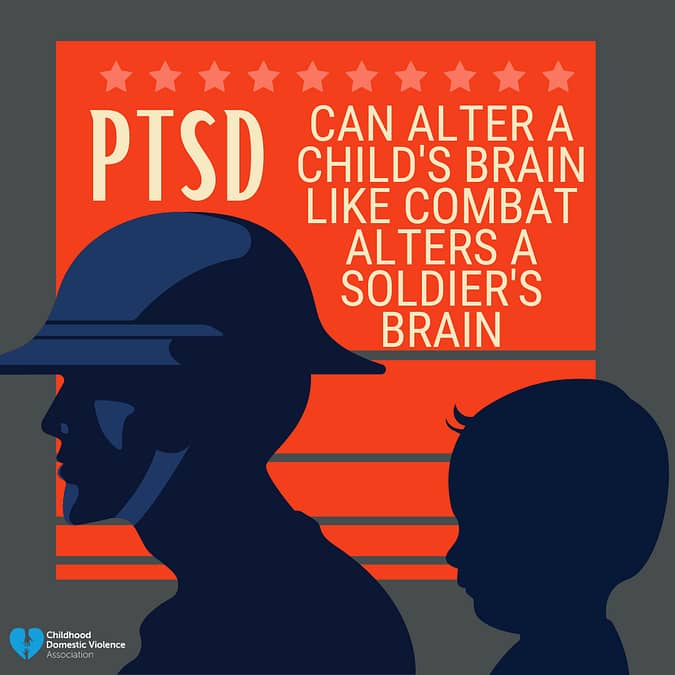Who do you think of first when you hear the term post-traumatic stress disorder (PTSD)?
Do most people think of a combat soldier, the war-hardened veteran? Or do they think of a child that is growing up with domestic violence? Did you know that both the soldier and child can develop Post-traumatic stress disorder (PTSD), producing many of the same symptoms and pitfalls impacting all areas of life with their respective experiences?
The children living with violence face a major adversity – childhood domestic violence (CDV). And the impacts of CDV can lead to disorders, such as PTSD in childhood. And for many of these children, both will impair their ability to thrive their entire lives without aid.
Post-Traumatic Stress Disorder (PTSD)
Before looking further into statistics or comparisons around PTSD, here is a quick definition, provided by the National Institute of Mental Health:
“PTSD is a disorder that develops in some people who have experienced a shocking, scary, or dangerous event. It is natural to feel afraid during and after a traumatic situation. Fear is a part of the body’s ‘fight-or-flight’ response, which helps us to avoid or respond to potential danger.”
Post-Traumatic Stress Disorder (PTSD) in Children
|
In the U.S., approximately 1 in 6 children have witnessed domestic violence in their lifetimes. More than 1 in 5 have witnessed other assaults in their families. One of the most common psychological responses to violence exposure is PTSD. |
 |
|---|
How is PTSD in a child growing up with domestic violence like that of a combat soldier?
CDV changes the patterns of the brain similarly to the way combat impacts a soldier’s brain. Like the soldier who experiences trauma in wartime, the trauma of CDV increases the risk of chronic health problems, mental illness, and substance abuse.
Children that grow up with domestic violence are more prone to obsessively worry, have more fears and feel more helpless. These feelings induce enough toxic stress in the body to change brain structure and cause disorders such as PTSD. Negative effects may include anxiety, nightmares, depression, withdrawal and aggression.
 |
And although the adult soldier has lived life longer than the child, the effects of PTSD are similar. They, like the children, develop brain patterns that change what they believe and how they would typically respond under less duress. The trauma of war and the trauma of domestic violence both rewire the brain in much the same way. |
What is post-traumatic growth?
On the flip side of PTSD, is Post traumatic growth – it’s the ability to experience positive changes after major trauma.
It is estimated that 50% – 66% of trauma survivors may experience post-traumatic growth. An important concept is that those who experience this growth, not only persevere, and become resilient. They also have the capacity to reflect, grow and shift one’s perspective.
And although not everyone will sustain Post traumatic growth, the research is improving and growing on how to help both child and adult get a better handle of their lives while living with PTSD. In most cases of PTSD, professional help is needed, but NIH offers up some suggestions of how anyone can provide support.
Helping children of domestic violence recover from PTSD
Children who experience domestic violence have the capacity for great resilience under adversity, though some of these children will develop PTSD. And some will require one or more forms of professional assistance.
PsychCentral.com provides a guideline for caregivers/parents broken down by age on how to help children that have developed PTSD.
Fortunately, more studies are being conducted and more awareness is being spread to show the connections of CDV to PTSD, and how it can rewire the brain. The striking comparison of two brains being rewired the same way shows how traumatic CDV is for a child- akin to combat conditions for a soldier.
If these children get the help they need, they will be able to step out of the shadow of CDV and PTSD and grow up to be the thriving adults they are meant to be.
To learn more about CDV and our work, visit cdv.org.

